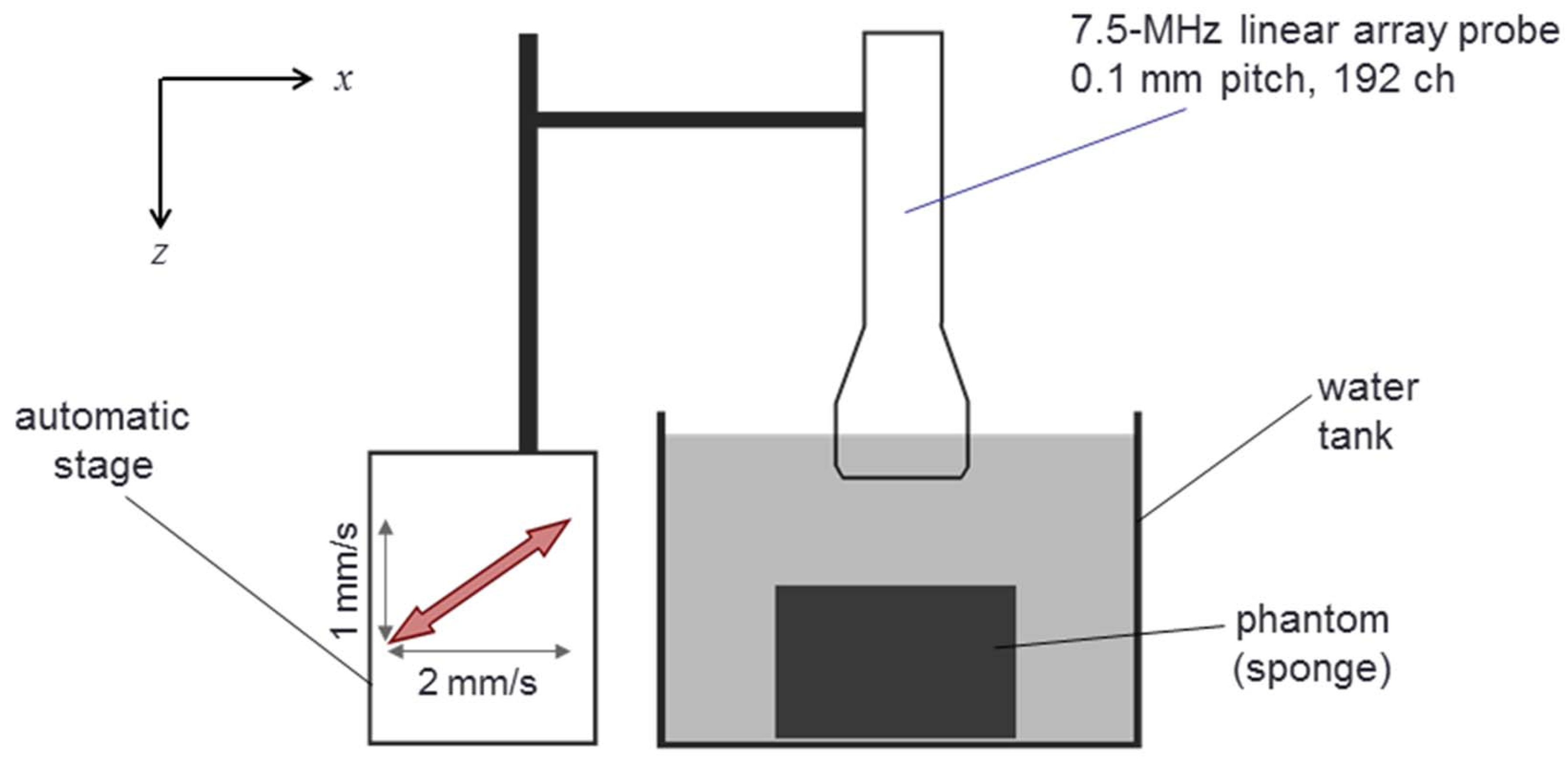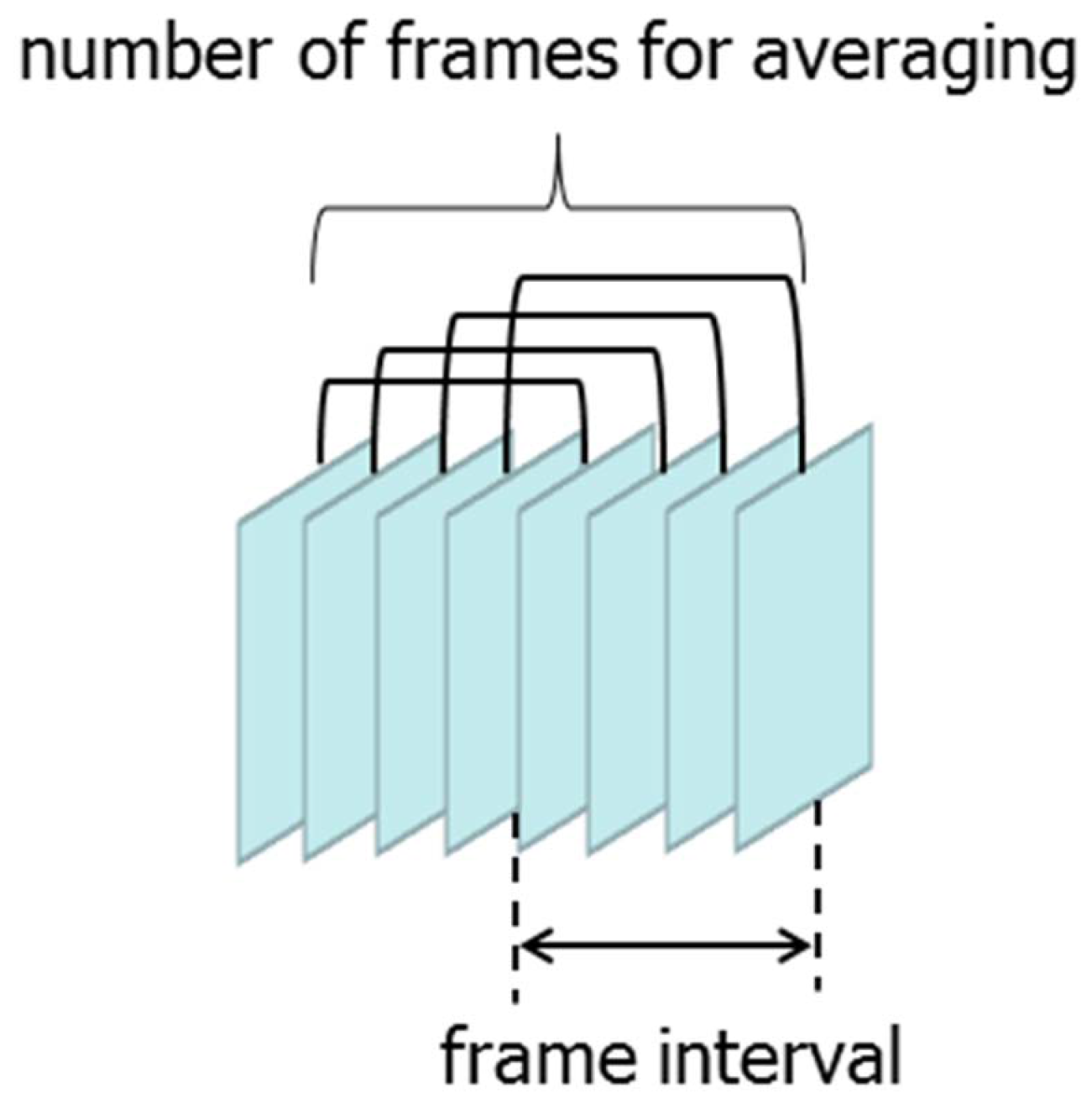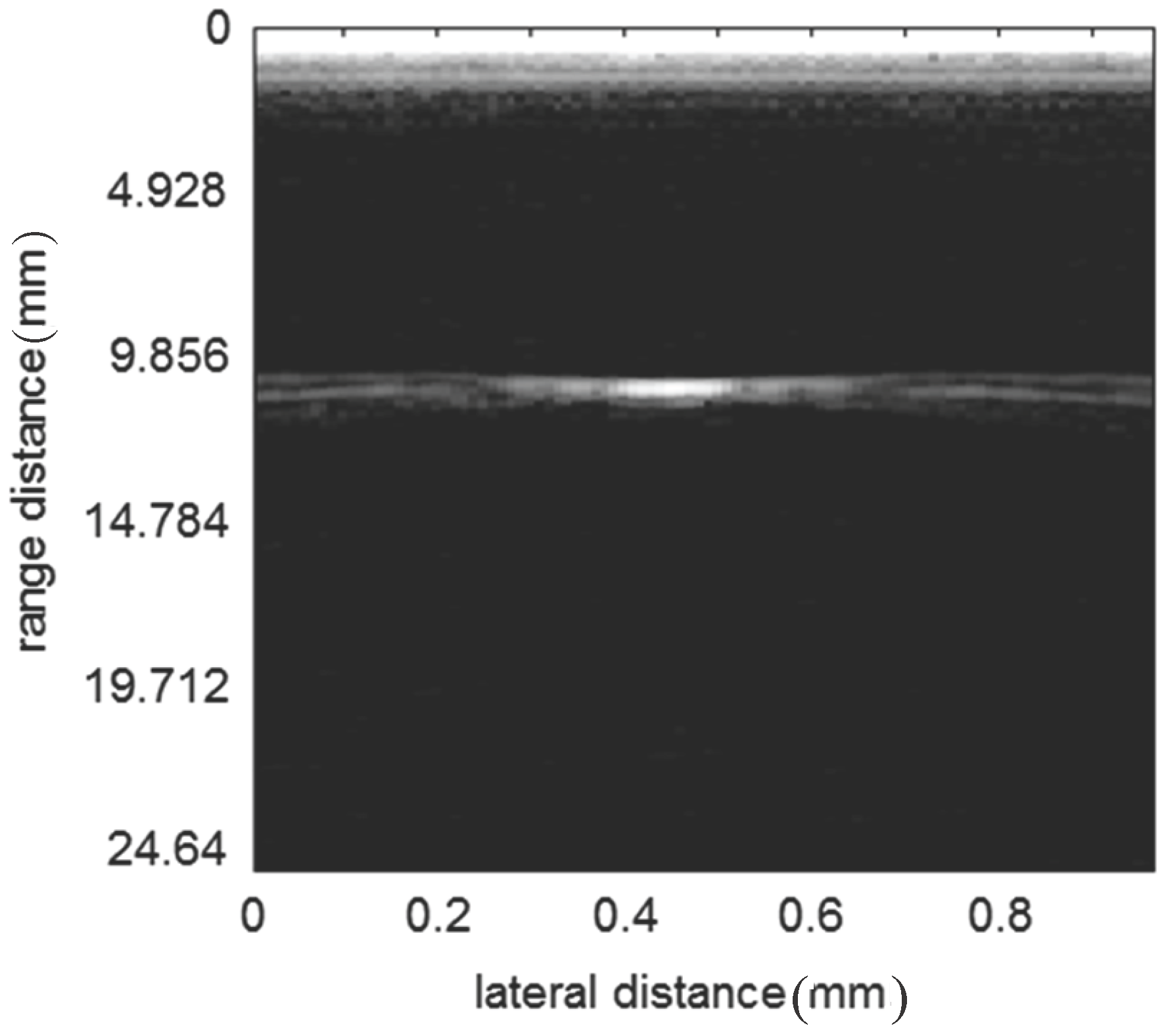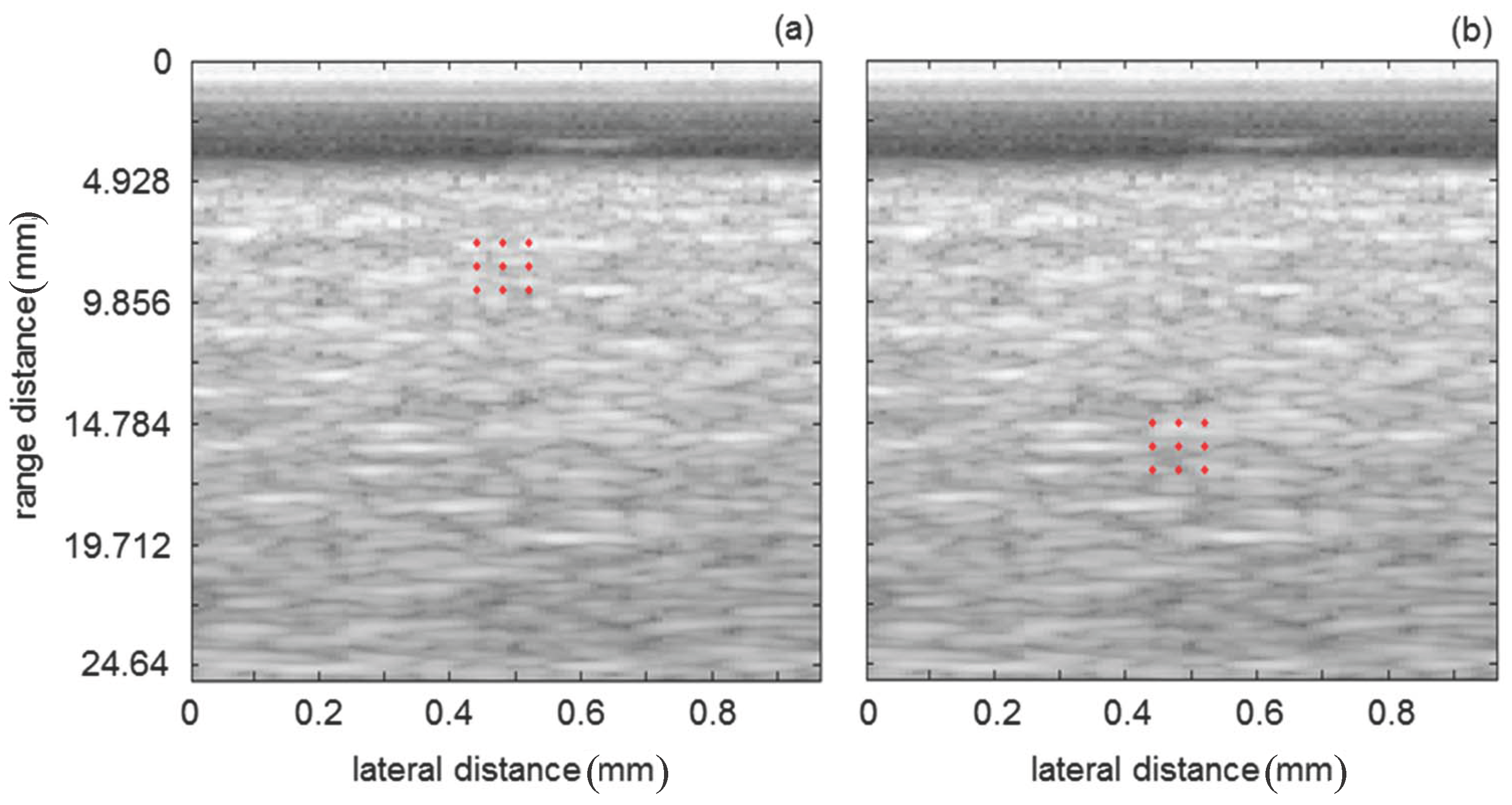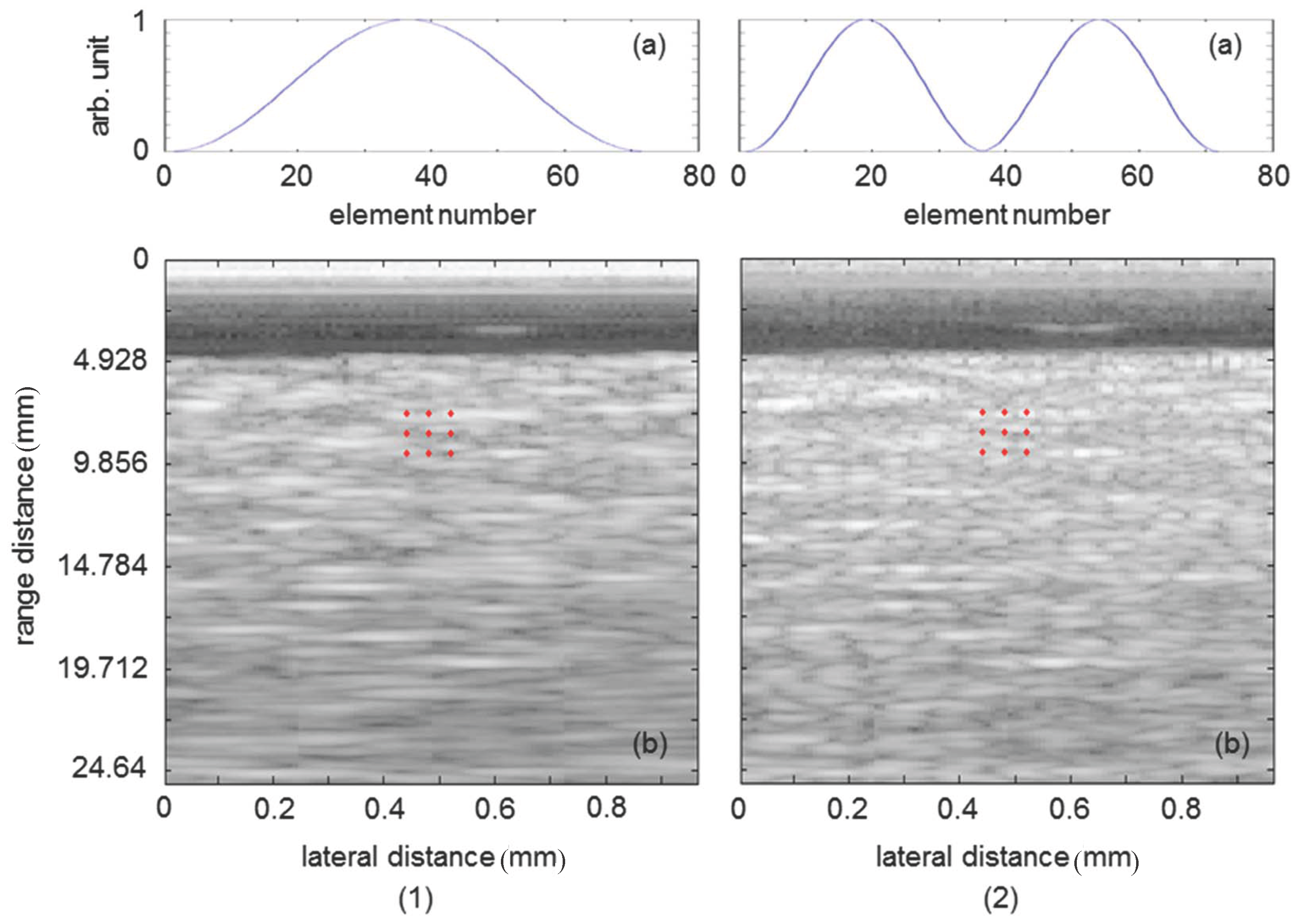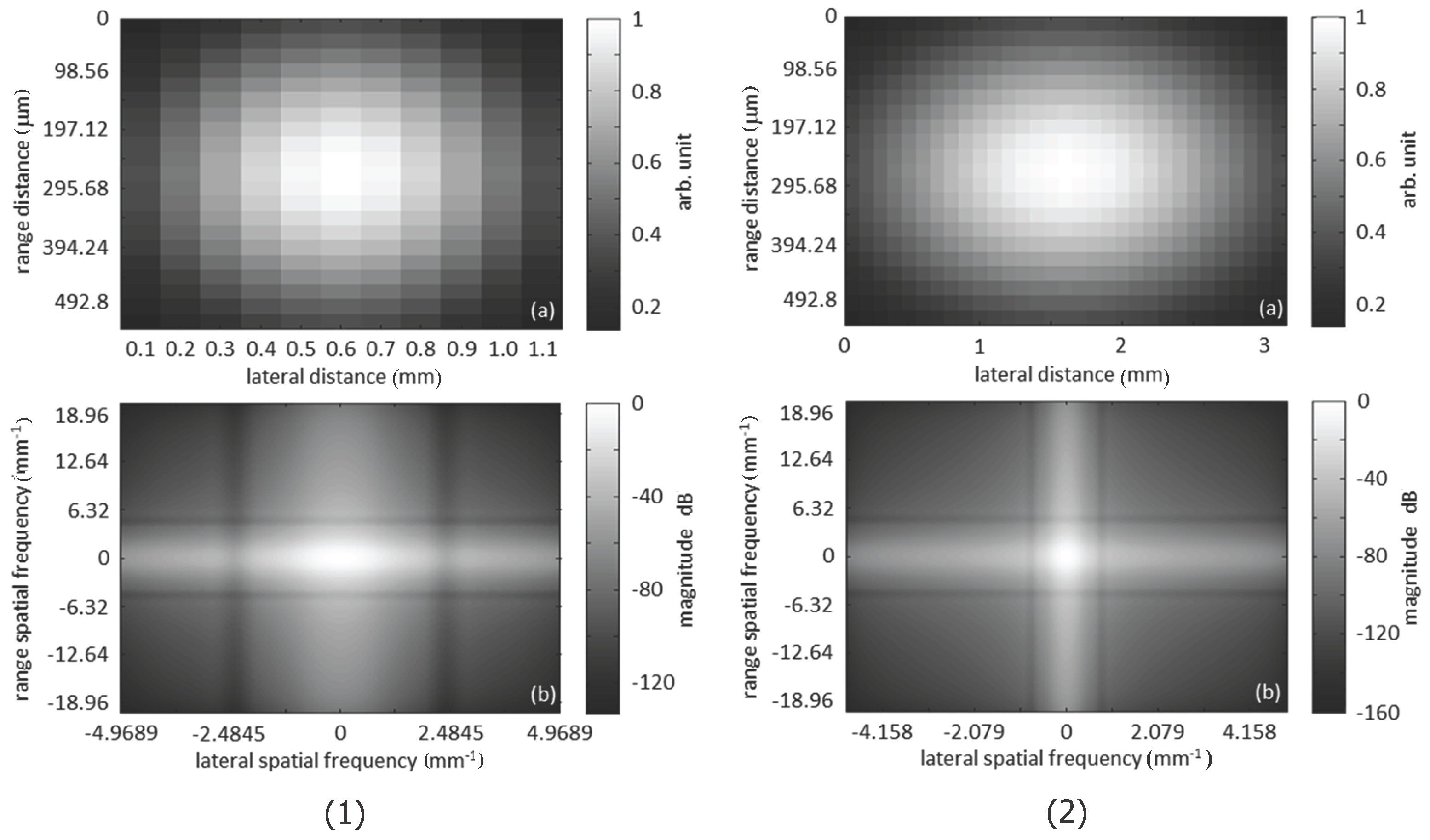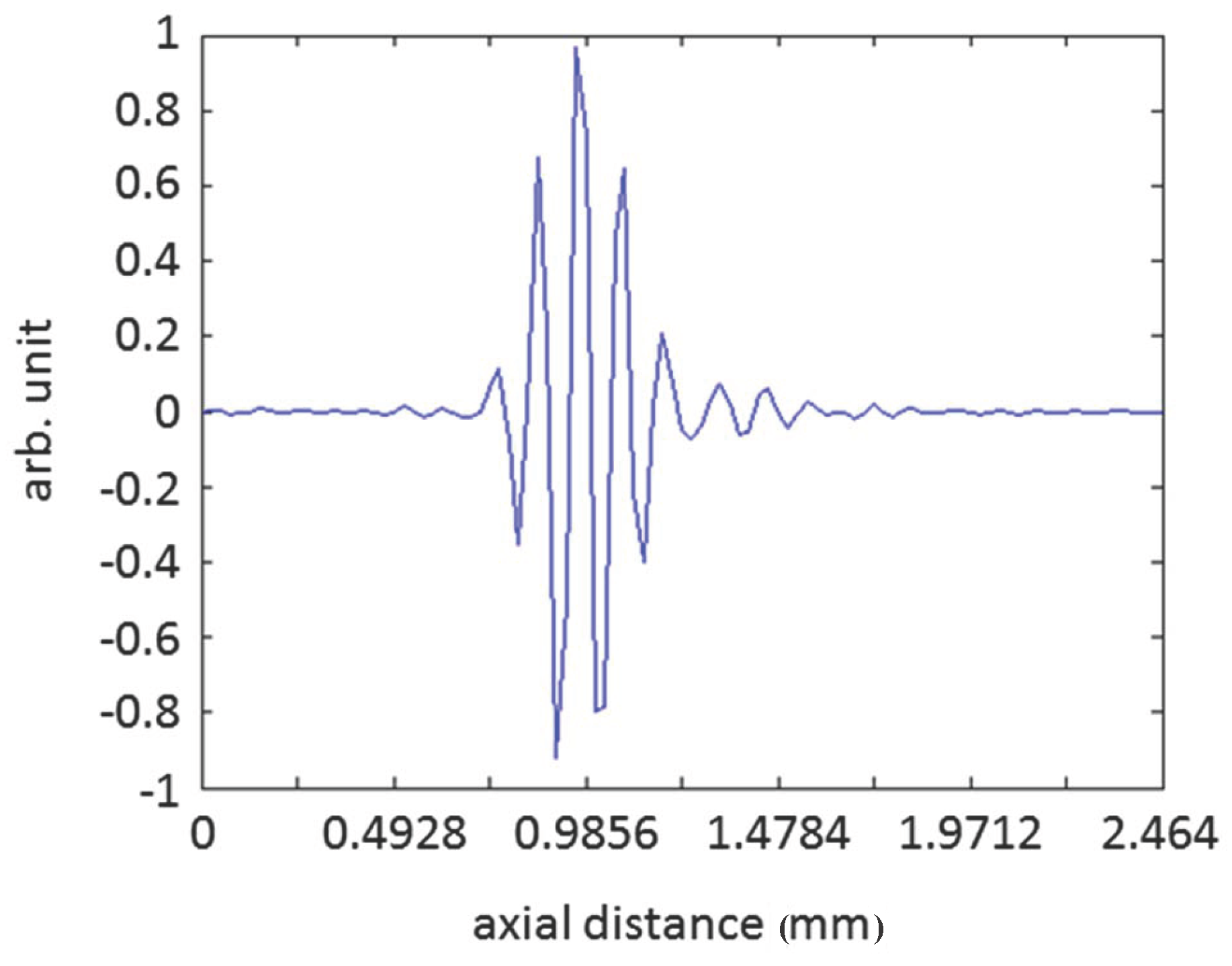1. Introduction
Functional ultrasound imaging, such as vascular elastography [
1,
2,
3,
4,
5] and myocardial contractility imaging [
6,
7,
8,
9], has shown to be useful for diagnosis of the cardiovascular system. Recently, high-frame-rate ultrasound has gained attention because it enhances such functional imaging by measurements of tissue dynamics at a very high frame rate of over one hundred Hz.
High-frame-rate ultrasound was first developed in 1980s [
10]. After the development of shear wave elastography by Tanter, et al. [
11], which was the first practical application of high-frame-rate ultrasound, various studies have been conducted for cardiovascular applications, such as vascular strain and blood flow imaging [
12,
13,
14], pulse wave imaging [
15,
16], and cardiac strain and blood flow imaging [
17,
18,
19,
20,
21]. In addition, various studies for improvement of the image quality in high-frame-rate ultrasound have been conducted [
22,
23,
24,
25,
26].
For such measurements of tissue dynamics, motion estimators are crucial. The autocorrelation method was introduced by Kasai, et al. as a phase-sensitive motion estimator for blood flow imaging [
27]. This method estimates the axial velocity of a target using the phase shift of the ultrasonic echo, but it suffers from the aliasing effect when the tissue displacement between consecutive ultrasound emissions is greater than half of the ultrasonic wavelength. In conventional ultrasonography, the imaging frame rate is typically tens of Hz. Under such a temporal resolution, the tissue displacement between frames can become larger than half of the ultrasonic wavelength, and phase-sensitive motion estimators possibly suffer from the aliasing effect. The speckle tracking method is suitable in such situations because it does not suffer from the aliasing effect. Therefore, the speckle tracking method is now widely used for estimation of tissue motion, such as in myocardial strain imaging [
9].
In high-frame-rate ultrasound, the tissue displacement between frames is significantly small owing to the high temporal resolution of over one hundred Hz. The speckle tracking method requires interpolation of the function, which is used for evaluation of the similarity of ultrasonic echoes in two frames, to estimate a sub-sample small displacement [
28]. Such an interpolation process could be a heavy computational cost in high-frame-rate ultrasound because a number of frames needs to be processed. In such situations, a phase-sensitive motion estimator is feasible because it can estimate a sub-sample small displacement without interpolation and does not suffer from the aliasing effect owing to the high temporal resolution. In the present study, phase-sensitive motion estimators were newly developed and examined for motion estimation with high-frame-rate ultrasound.
The autocorrelation approach, one of the common phase-sensitive motion estimators, was first used for estimation of the axial motion [
27,
29]. Then, the phase-sensitive method was expanded to the 2D motion estimators using 2D frequency spectra of ultrasonic echoes [
30] and the complex analytical signal obtained by modulating the ultrasonic field [
31] or the Hilbert transform [
32,
33,
34,
35]. In the present study, 2D motion estimators using 2D frequency spectra of ultrasonic echoes were developed, and the accuracies of the proposed methods were compared with that of the conventional method by the phantom experiments.
3. Experimental Results
To evaluate the spatial resolution of the imaging method described in
Section 2.4, an echo from a fine stainless wire of 15
m in diameter was measured in water.
Figure 3 shows a B-mode image of the wire obtained with rectangular apodization. The lateral and axial widths at half maximum of the point spread function were 0.81 mm and 0.27 mm, respectively.
Figure 4a shows the B-mode image of the sponge phantom. The nine red points show the points of interest, at which the lateral and axial motion velocities are estimated. Examples of the estimated lateral and axial velocities are shown in
Figure 5. As shown in
Figure 5, at the beginning of the movement, there are undesirable vibrations of the metal arm, which supports the ultrasonic probe, due to the rapid acceleration of the automatic stage. Therefore, errors in the estimated lateral and axial velocities were evaluated during the period from 154 to 235 ms (25 frame sets) in
Figure 5, when the undesired vibrations were attenuated. In the present paper, the bias error
and standard deviation
σ of the estimated lateral and axial velocities were evaluated as follows:
where
is the lateral or axial velocity at
p and
n, which denote the points of interest (
) and the frame set number (
), respectively,
denotes averaging with respect to
p and
n,
is the lateral or axial velocity averaged with respect to the points of interest and frame sets, and
is the actual lateral or axial velocity, which was set to the automatic stage.
Table 1 and
Table 2 show the bias errors
and standard deviations
σ of the lateral and axial velocities estimated by the conventional 2D motion estimator without and with frame averaging, respectively. The bias errors
in the estimated lateral velocities were large when the lateral window size was less than ±1.5 mm (
). On the other hand, the bias errors
in the estimated axial velocities were very low (equal to or less than 3%) at all the examined window sizes. Both for the lateral and axial velocities, the standard deviations
σ were significantly reduced by frame averaging.
Table 3 shows the bias errors
and standard deviations
σ of the lateral and axial velocities estimated by the proposed paired 1D motion estimators. Using the proposed paired 1D motion estimators, the bias errors
of the estimated lateral velocities at small lateral window sizes of less than ±1.5 mm (
) were improved significantly compared with those of the conventional 2D motion estimator shown in
Table 2, but the standard deviations
σ were increased. The bias errors
of the estimated axial velocities were very small (equal to or less than 2%) at all the examined window sizes.
Table 4 shows the bias errors
and standard deviations
σ of the lateral and axial velocities estimated by the proposed 2D motion estimator. At all the examined lateral window sizes, the bias errors
of the estimated lateral velocities were improved dramatically compared with those of the conventional 2D motion estimator shown in
Table 2. Also, the bias errors
of the estimated axial velocities were very small (equal to or less than 2%) at all the examined window sizes.
For a graphical representation of the results, means and standard deviations of the lateral and axial velocity estimates summarized in
Table 1,
Table 2,
Table 3 and
Table 4 are plotted in
Figure 6a,b, respectively, as functions of the lateral window size. In
Figure 6, the velocity estimates obtained with an axial window size of ±0.2464 mm are shown as a typical case because the velocity estimates are more dependent on the lateral window size. As can be seen in
Figure 6a, the accuracy in estimation of the lateral velocity was improved significantly, particularly in cases of smaller lateral window sizes. On the other hand, the accuracy in estimation of the axial velocity was much less dependent on the window size.
To obtain the results shown in
Table 1,
Table 2,
Table 3 and
Table 4, rectangular apodization was used in receive beamforming to obtain the beamformed RF signals, which were analyzed by the conventional and proposed motion estimators to obtain the lateral and axial velocity estimates.
Figure 7(1-b,2-b) show B-mode images of the phantom obtained with Hanning apodization and apodization consisting of two Hanning functions (lateral modulation), respectively.
Table 5 shows the errors
and standard deviations
σ of the lateral and axial velocities estimated by analyzing the RF signals beamformed with Hanning apodization using the proposed 2D motion estimator. Although the bias errors
and standard deviations
σ of the estimated axial velocities are very similar to those obtained with rectangular apodization shown in
Table 4, the bias errors
and standard deviations
σ of the lateral velocity estimates are degraded. The lateral velocity estimates obtained with lateral modulation (
Table 6) are much better than those obtained with Hanning apodization (
Table 5), but the lateral velocity estimates obtained with rectangular apodization (
Table 4) are significantly better than those obtained with lateral modulation when the lateral window size is smaller than ±1.5 mm (
).
In ultrasonic imaging, the point spread function varies with depth, i.e., the spatial resolution in a deep region is worse than that in a shallow region. To examine the effect of the change in the point spread function on the accuracies of the estimators, errors in the displacements estimated at nine red points shown in
Figure 4b were also evaluated.
Table 7 and
Table 8 show the bias errors
and standard deviations
σ of the lateral and axial velocity estimates obtained by the conventional and proposed 2D motion estimators, respectively, with rectangular apodization. The lateral velocity estimates obtained by the conventional 2D motion estimator were much more affected by degradation of the spatial resolution than those obtained by the proposed 2D motion estimator. For both methods, the axial velocity estimates were less dependent on depth.
Furthermore, the proposed method was evaluated with a different motion velocity of the automatic stage, i.e., lateral and axial velocities of 1 mm/s and 0.5 mm/s, respectively.
Table 9 and
Table 10 show the lateral and axial velocities estimated at the same points shown in
Figure 4a obtained by the conventional and proposed 2D motion estimators, respectively. As in the results with higher lateral and axial velocities shown in
Table 2 and
Table 4, respectively, bias errors
in the lateral velocity estimates were significantly reduced by the proposed method at a small lateral window size of
mm.
4. Discussion
In the present study, two phase-sensitive motion estimators, namely, the proposed paired 1D motion estimators and the proposed 2D motion estimator, were developed and examined by the phantom experiment. Both proposed methods significantly reduced the bias errors in the lateral velocity estimates compared with the conventional 2D motion estimator particularly when the lateral window size was small. However, the performance of the proposed paired 1D motion estimators was worse than the proposed 2D motion estimator. The reason for this can be considered as follows: To estimate the displacement in the direction of interest (lateral or axial direction), Salles et al. remove the phase shift of the ultrasonic echo caused by the displacement in the other direction from the total phase shift using the narrow band analytical signal obtained by the Hilbert transform [
35]. In the proposed paired 1D motion estimators, similar procedures were done by Equation (
7) by assuming that the absolute values of the mean frequencies of the components
and
were same, i.e.,
. However, the absolute values of the mean frequencies of the components
and
were not always same due to the ambiguity in the mean frequency of each component of the spectrum, particularly when the window size was small, as described in
Section 2.3. As a result, the velocity estimate in the direction of interest was degraded because the phase shift caused by the displacement in the other direction was not removed accurately from the total phase shift. The proposed 2D motion estimator realized the best performance among the three methods examined in the present study because it did not assume that the absolute values of the mean frequencies of the components
and
were same and estimates the mean frequency of each component of spectrum.
As shown by the results in
Table 2, the conventional 2D motion estimator requires a window size, which is larger than or equal to ±1.5 mm (
) in the lateral direction and ±0.2464 mm (
) in the axial direction, to reduce the bias error in the lateral velocity estimates. The Gaussian spatial windows used in the discrete Fourier transform and their frequency spectra are shown in
Figure 8.
Figure 8(1-a) shows the Gaussian window with the lateral and axial sizes of (±0.5 mm (
), ±0.2464 mm (
)), respectively, and
Figure 8(1-b) shows its power spectrum.
Figure 8(2-a,2-b) show those of the Gaussian window with the lateral and axial sizes of (±1.5 mm (
), ±0.2464 mm (
)), respectively. The lateral widths at half maximum of the main lobe of the power spectra shown in
Figure 8(1-b,2-b) are 1.24 mm
and 0.42 m
, respectively. Therefore, the results obtained in the present study showed that the main lobe width of less than or equal to 0.42 mm
was required to obtain accurate lateral velocity estimates by the conventional 2D motion estimator. The main lobe width was compared with the size of the point spread function of the beamformed ultrasonic data. The lateral width at half maximum of 0.42 m
corresponds to about three times of the lateral width at half maximum of the point spread function shown in
Figure 3 [
].
On the other hand, the accurate axial velocity estimates could be obtained even with a smaller axial window size of ±0.1232 mm, which almost corresponds to the axial size of the point spread function.
Figure 9 shows the beamformed RF signal obtained along the scan line, which pass through the peak of the point spread function shown in
Figure 3. As can be seen in
Figure 9, in the axial direction, there are about three cycles of the ultrasonic signal in the axial width at half maximum of 0.27 mm of the point spread function, which almost corresponds to an axial window size of ±0.1232 mm. In the lateral direction, it can be considered that there is only one cycle of signal variation within the point spread function. Therefore, a window size of three times of the point spread function was required in the lateral direction to include three cycles of the ultrasonic signal variation. From these results, it was supposed that the conventional 2D motion estimator gives accurate velocity estimate when the spatial window includes about three cycles of the ultrasonic signal variation in both lateral and axial direction.
As described above, the conventional 2D motion estimator requires a relatively large spatial window to obtain accurate lateral and axial motion estimates. On the other hand, the proposed 2D motion estimator realizes accurate estimation of the lateral and axial motion with a smaller spatial window. Such a property of the proposed 2D motion estimator is preferable for more regional measurement of the tissue motion by means of ultrasound.
In this study, the basic concept of the proposed 2D motion estimator was presented, and the proposed method was implemented with a linear array probe. Also, the feasibility of the proposed method for 2D motion detection was shown by a primitive phantom experiment. In future work, an experimental validation using a more realistic phantom should be performed and, also, the proposed motion estimator should be implemented with phased and curved arrays.
